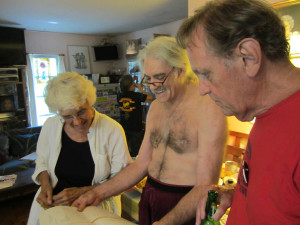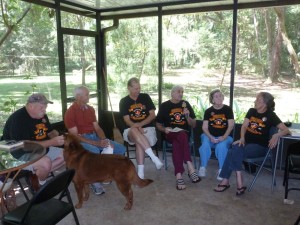 by Jessica Newman
by Jessica Newman
On Aug. 31, 1973, the Gainesville Eight were acquitted of charges of conspiracy to violently disrupt the 1972 Republican National Convention in Miami Beach. Their acquittal came at the end of a 14-month long, highly publicized legal battle, and many of the truths it exposed still ring true today. That’s why, 40 years later, three of the original defendants (Scott Camil, Peter Mahoney and Don Perdue) and 12 others involved with the trial reunited in Gainesville—preserving history to prevent it from repeating itself.
The Gainesville Eight were made up of eight anti-war activists, seven of whom were members of Vietnam Veterans Against the War (VVAW). Their plans for a peaceful, anti-war demonstration at the 1972 RNC were disrupted by law enforcement agents—from the Federal Bureau of Investigation on down to the Dade County Public Safety Department—who infiltrated the group and attempted to sway VVAW toward a more violent approach.
Eventually, the Gainesville Eight were indicted by grand jury investigation with conspiracy “to organize numerous ‘fire teams’ to attack with automatic weapons fire and incendiary devices police stations, police cars and stores in Miami Beach” using “lead weights, ‘fried’ marbles, ball bearings, ‘cherry’ bombs, and smoke bombs by means of wrist rocket slingshots and cross bows.”
The Gainesville Eight posed only a political threat to the U.S. government, if they posed any threat at all. They came back from Vietnam; they had seen firsthand what was going on there. And people listened to them.
 “… We have been to Vietnam, so the government could not say that we weren’t willing to serve our country,” said defendant Scott Camil in his opening statement. “We have first-hand knowledge of what was really being done in Vietnam, in the name of the American people, and the government can’t claim that we don’t know what we are talking about because we did it.”
“… We have been to Vietnam, so the government could not say that we weren’t willing to serve our country,” said defendant Scott Camil in his opening statement. “We have first-hand knowledge of what was really being done in Vietnam, in the name of the American people, and the government can’t claim that we don’t know what we are talking about because we did it.”
In its prosecution of the Gainesville Eight, the government manufactured evidence by using agent provocateurs and informants, lied under oath, and eavesdropped on confidential client-attorney deliberations. Federal Judge Winston Arnow placed unreasonable limitations on the evidence that could be brought by the defense, and not a single defendant testified during the month-long trial.
“The judge did everything he could to rule against the defense,” said Brady Coleman, a Texas National Lawyers Guild attorney at the time from the Gainesville Eight’s trial team.
One of Coleman’s most memorable moments from the case was when the defense team, after a long day at trial, went to confer in their supposedly private room of the courthouse. But on the way, defendant Peter Mahoney saw the shadow of two men hiding behind a behind a door in the corridor. The defense team summonsed the judge, who sent U.S. Marshals to investigate. When the door opened, they found two FBI agents covered in wires and electronic gear, allegedly listening in on the defense’s confidential deliberations.
Another noteworthy moment from the trial was when the prosecution called Emerson Poe to the stand. Poe was one of the 23 VVAW members subpoenaed to testify before a grand jury just prior to the indictment of the Gainesville Eight. The government testified, under oath, that none of those 23 people were government informants. But Poe, who was thought to be a very close friend and confidante of defendant Scott Camil, turned out to be working for the government all along. Effectively, Poe had “infiltrated the defense camp, had been represented for a time by defense attorneys, had eavesdropped on defense strategy,” according to an article from the Nation from October 1973.
In the end, the fate of the Gainesville Eight was in the jury’s hands. The jury deliberated only 4 hours before reaching a verdict of “not guilty.”
Now, 40 years later, those who attended the Gainesville Eight reunion last month saw, for the first time, what it was like for the jurors during the trial. Lois Hensel, the jury foreperson, is now deceased, but her husband Jim who still lives in Gainesville came to the reunion. With him he brought a box of artifacts from the trial, or a “treasure trove,” as Camil called it.
Contained in Hensel’s box was everything the jury had received from the trial—including the newspapers with all political coverage snipped out, Lois Hensel’s notes about each of the personalities from the case, and even the “guilty” packet from the court that she would have signed had the jury ruled differently.
“I never really thought about the trial from the jury’s perspective, but their sequestration really impacted their lives and their families’ lives,” Camil said. “The most important thing you can do in this country, the most powerful action you can take is to sit on a jury. It’s more important than voting.”
Camil, Don Perdue and Peter Mahoney from the Gainesville Eight were present in Gainesville for the reunion. Also present were three other VVAW members who were subpoenaed to the grand jury, Richard Hudgens, John Chambers, Jack Jennings. John and Jack spent 40 days in jail for refusing to testify to that grand jury. Three of the trial lawyers, members of the defense committee, one juror, and two husbands of jurors attended as well. The reunion was organized by Camil with the main goal of recording their history—the people’s history—before it disappeared. Because the Gainesville Eight’s story is not the kind of story that’s written down in history books; it’s not the kind of history that those in power want to remind people of.
Students and staff from the University of Florida Samuel Proctor Oral History Program (SPOHP) also attended the weekend’s festivities and interviewed all but two of the reunion attendees involved in the trial. The transcripts of those interviews will be combined with the case’s primary source documents from different people involved in the case (like Jim Hensel’s “treasure trove”) to form the Gainesville Eight Collection, maintained by SPOHP.
“This generation needs to know [the Gainesville Eight] history so they don’t repeat it,” said Nancy Miller Saunders, another attendee of the reunion and member of the defense committee. Saunders eventually went on to write Combat by Trial about her experience working with anti-war veterans and the trial itself.
“It’s important to see when the government makes mistakes,” said Nancy Stearns, defense attorney for the Gainesville Eight from the Center for Constitutional Rights.
It’s how we hold them accountable; it’s how democracy works. But whistleblowers and those who work for transparency today—Julian Assange, Chelsea Manning, Edward Snowden—are being persecuted in exactly the same way, if not more ruthlessly.
Like the Gainesville Eight, the whistleblowers of today are laying bare the dirty laundry of the U.S. government. And just like the government tried to silence the VVAW and other anti-war activists in the 1970s—through lies, through intimidation, through surveillance and secrecy—those in power are trying to silence, to criminalize and demonize, to discredit the modern-day heroes of transparency.
But while there are a lot of parallels to draw between the Gainesville Eight case (and similar cases from that era) and today, things are undeniably worse now.
“Nixon was hobbled by laws that Bush started removing after 9/11,” Saunders said.
Nixon tried to justify Watergate and his crackdown on radicals like VVAW as actions in the nation’s best interest. He painted the VVAW as a “grave threat to national security,” according to an August 1973 article in Ramparts. Sound familiar?
Indeed, President Obama has brought seven indictments for whistleblowers under the Espionage Act; before him, there were three presidents who each brought one.
“The people are supposed to have the privacy, and the government is supposed to be transparent,” Camil said. “But now it’s all backwards. The people have no privacy and the government has no transparency.“
Amy Goodman summarized the current state of whistleblowing best on Aug. 22 in an editorial for TruthDig: “Miranda is rattled, but free. Manning will soon head, shackled, to begin serving his sentence. NSA whistle-blower Edward Snowden remains in temporary political asylum somewhere in Russia, and WikiLeaks founder Julian Assange continues his residence in exile, not far from Heathrow, in the cramped Ecuadorean Embassy in London.”
This is why the people’s history is important, like that of the Gainesville Eight’s. And it’s why the whistleblowers of today need our support. Because the people can’t perform their job in a democracy without being informed.
A common theme throughout the Gainesville Eight trial, repeatedly iterated by the pro-prosecution judge, was, “The government is not on trial here.”
But it was, and it still is today. Whistleblowers and truth-seekers may be our best chance at putting the government back on trial.
“I see the government really as the people’s employee, and we’re the employer,” Camil said. “We have to hold them accountable, and we can’t do that without access to information.”
